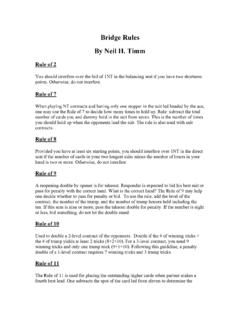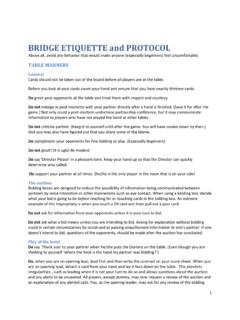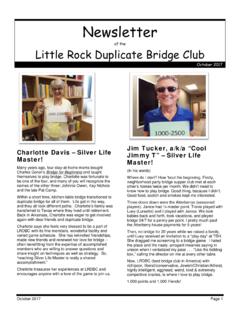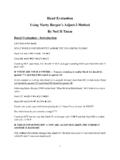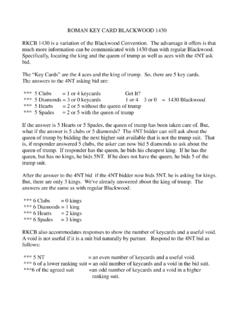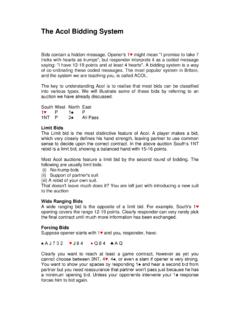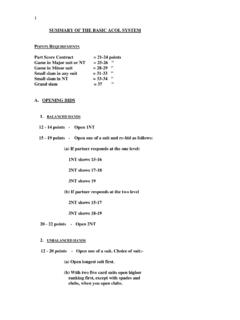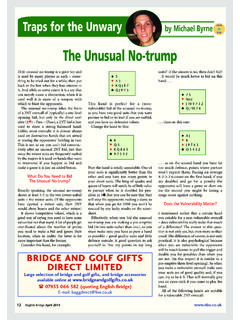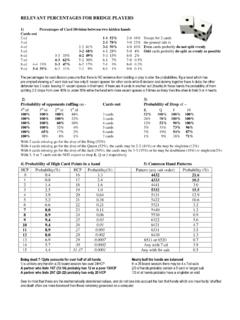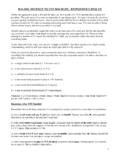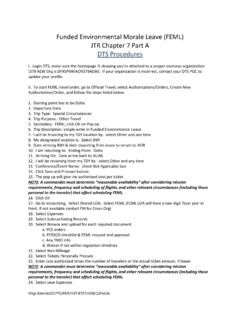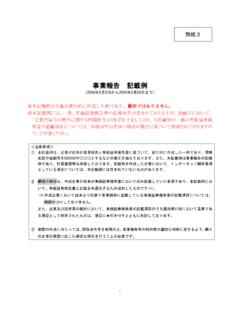Transcription of STAYMAN AND TRANSFERS OVER ONE NO TRUMP
1 STAYMAN AND TRANSFERS OVER ONE NO TRUMP INTRODUCTION Because the 1NT bid is so narrowly defined, it is relatively easy to develop a good system of bidding around it. Most of the efficient systems of bidding after a 1NT opening incorporate the use of STAYMAN and TRANSFERS . Basic STAYMAN is one of the first conventions learnt by the beginner. A response of 2C to an opening bid of 1NT asks opener if he holds a 4-card major, if he has, he bids it, otherwise he bids 2D. It is generally considered much more useful to use the 2C bid for this purpose than to retain its natural meaning. A Transfer bid is the bid of a suit below the one held and it normally asks partner to bid the suit that has been shown.
2 Transfer bidding represents one of the greatest developments in modern day bridge. The main way in which transfer bidding is used today is after 1NT and 2NT opening bids. The use of TRANSFERS is inextricably intertwined with the use of STAYMAN . The two cannot be separated. Some hands are best described using STAYMAN , others by TRANSFERS . STAYMAN Whenever responder bids 2C over 1NT he guarantees at least one four card major. If opener hold both majors he should always bid 2H. A - Weak Hands STAYMAN can be used to try to improve the contract when responder has a weak hand. There are two advantages.
3 Firstly, the contract is often improved and rarely worsened. Secondly, if responder has a very weak hand it is usually a good idea to bid over 1NT before it is doubled. All simple changes of suit after the response to STAYMAN are weak. If the response to STAYMAN is 2D, then 2H shows both majors and asks opener to pass with a trebleton or give preference to 2S with a doubleton heart and a trebleton spade. Consider this very weak hand S xxxx H Qxxx D xxx C xx It is unlikely that any contract will stand much chance, but any contract doubled will certainly be worse and it is very likely that the next hand will double 1NT if you pass and now they may find it easier to double you in two of a major.
4 If partner holds a 4 card-major, the hand will best be played in two of that major, and even if partner has no 4-card major it may still play as well in two of a major as it would in 1NT. It would also be sound to bid 2C on a hand such as S KJxx H QJxx D xx C xxx With two relatively strong 4-card majors it is usually best to use STAYMAN this way. If partner does not hold a 4-card major the hand may play better in 1NT, but the odds favour investigating the major suit fit. If the response to STAYMAN is 2D, then 2S shows a 4-card spade suit and good support for both minors. Opener should generally pass with a trebleton spade, or, with only two spades, either bid three of a minor or 2NT to ask responder to choose the minor.
5 The following hand should be bid this way :- S QJ10x H x D Jxx C xxxxx If partner has a trebleton spade and passes 2S, the hand should play well in the 4-3 fit, if partner has only two spades, he will have a 5-card minor which he will bid or he will have two 4-card minors in which case he will bid 2NT and you will be delighted to choose to play in 3C. If the response to STAYMAN is 2H, then a continuation of 2S is as above, showing four spades and good support for both minors. If the response to STAYMAN is 2H or 2S, bids of 3C or 3D are weak and natural. The same applies to a bid of 3C if the response to 2C is 2D.
6 However these weak hands will always contain a 4-card major, so opener may correct to what he knows will be a better contract. This usually only happens if the response to STAYMAN is 2H, since opener may well also hold four spades in which case he will correct three of a minor to 3S. The following hand is an example:- S Qxxx H x D K10xxxx C xx Over partner's 1NT opening, bid 2C. If partner responds 2D or 2S pass. If partner bids 2H, bid 3D. Partner knows that you hold four spades, so if he was dealt with both majors, he will correct the contract to 3S. B - Medium Strength Hands (ie. with possible game interest) A 2NT rebid by responder after STAYMAN is a natural limit raise, asking opener to bid on with a maximum.
7 Opener should bear in mind that at least one 4-card major will be held. Therefore the sequence 1NT - 2C - 2H -2NT, promises a 4-card spade suit, so if opener is 4/4 in the majors, he should bid either 3S or 4S over 2NT. Responder's hand will be something like:- S KJxx H Qx D AJx C 10xxx If the response to STAYMAN is a major, a raise of that major is also a limit bid and asks opener to proceed to game if he is a maximum. If the response to STAYMAN is 2D, a raise to 3D shows 5/5 in the majors, and in principle, a hand with the values to invite game. Opener should bid his better 3-card major and bid it at the three level if his hand is unsuitable or at the four level if suitable.
8 After this 3D bid, responder's hand will be something like:- S KJ10xx H AQxxx D x C xx This 3D bid may be used on certain hands with game going strength. For example, by bidding in this way you can ensure that opener will play the hand. S KQJ10x H KQJ10x D x C xx The final contract is always going to be four of a major so all you have to do is raise partner's choice of major to game. The only other sort of medium strength hand which responder may wish to describe is one that contains five hearts and four spades. For reasons which will be made clear in the section on TRANSFERS , it is not possible to bid these hands via TRANSFERS .
9 The following sequence is non-forcing and shows five hearts and four spades, 1NT - 2C - 2D -3H. This may well be used on a hand such as:- S AQxx H KJ10xx D Jxx C x Opener with a minimum can now pass, and with a maximum bid either 3NT, 4H, or occasionally 4S. If the response to STAYMAN is two of a major, obviously responder should raise to game on this particular hand, whilst on other hands it would be sufficient to raise to the 3-level. C - Strong Hands (ie. strong enough to insist on game) Most really strong hands are not bid via STAYMAN but via TRANSFERS or immediate jump bids, so in this section we are concerned with hands which are good enough to insist on game but wish to offer some choice of denomination.
10 If after using STAYMAN , responder bids 3NT, this is to play and should always be passed except in one instance. This is when the response to STAYMAN was 2H. On this occasion when responder jumps to 3NT it is known he holds a 4-card spade suit, so opener should correct to 4S if he holds this suit. If opener shows a 4-card major in response to STAYMAN , and it is the major in which responder is interested, he is likely to jump to game. However, if responder has some slight slam ambition, say an attractive looking 16-count, he may well make a jump cue-bid. For example, with:- S KJxx H Kx D KQxxx C Ax after the sequence:- 1NT - 2C - 2S, the hand is worth 4C.
